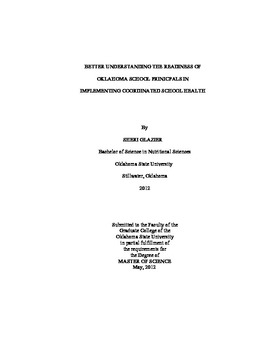| dc.contributor.advisor | Hildebrand, Deana | |
| dc.contributor.author | Glazier, Sheri | |
| dc.date.accessioned | 2014-04-15T22:01:12Z | |
| dc.date.available | 2014-04-15T22:01:12Z | |
| dc.date.issued | 2012-05-01 | |
| dc.identifier.uri | https://hdl.handle.net/11244/9231 | |
| dc.description.abstract | There is evidence to suggest that school health programs are one of the most efficient ways to reduce risky behavior and prevent health problems in children, however, many school health programs, specifically Coordinated School Health (CSH), are not implemented in many schools. The scope of this study was to assess the readiness of Oklahoma public school principals to implement CSH. Data for the study was collected from the School Health Survey of Oklahoma School Principals. Using the stages of change model, a two-item algorithm was used to determine the level of readiness for the 269 responding principals to implement CSH at their school. Independent sample t-tests were used to compare stage of readiness by grade classification and geographical classification of the responding schools that the principals represent. A one-way ANOVA was used to compare the stage of readiness versus the size of school. Four barrier and four benefit items were converted to T-scores and compared to stage of readiness. A regression analysis was used to determine correlation between efficacy items and stage of change. Finally, a content analysis was conducted to identify themes in the principals' comments. It was found that nearly 1/3 of the respondents were in the precontemplation and contemplation stages, and almost 2/3 of principals were in the action/maintenance stages. Principals in rural areas seem to be in a lower stage of readiness compared to those in urban areas. Items that best predicted principals' readiness to implement CSH were, teachers understanding and supporting their role in the program, and support from the school district's school board. In addition, principals in lower stages felt that teachers needed more professional development to implement CSH. This information can be used in developing state appropriate messages for principals and decision makers regarding the need of Oklahoma schools so that funding, time and community resources can be allocated appropriately and ultimately improve the health of faculty and students. | |
| dc.format | application/pdf | |
| dc.language | en_US | |
| dc.publisher | Oklahoma State University | |
| dc.rights | Copyright is held by the author who has granted the Oklahoma State University Library the non-exclusive right to share this material in its institutional repository. Contact Digital Library Services at lib-dls@okstate.edu or 405-744-9161 for the permission policy on the use, reproduction or distribution of this material. | |
| dc.title | Better Understanding the Readiness of Oklahoma School Principals in Implementing Coordinated School Health | |
| dc.type | text | |
| dc.contributor.committeeMember | Betts, Nancy M. | |
| dc.contributor.committeeMember | Shriver, Lenka | |
| osu.filename | Glazier_okstate_0664M_11935.pdf | |
| osu.college | Human Environmental Sciences | |
| osu.accesstype | Open Access | |
| dc.description.department | Department of Nutritional Sciences | |
| dc.type.genre | Thesis | |
